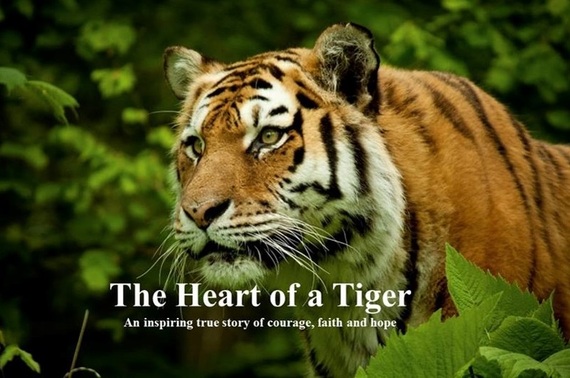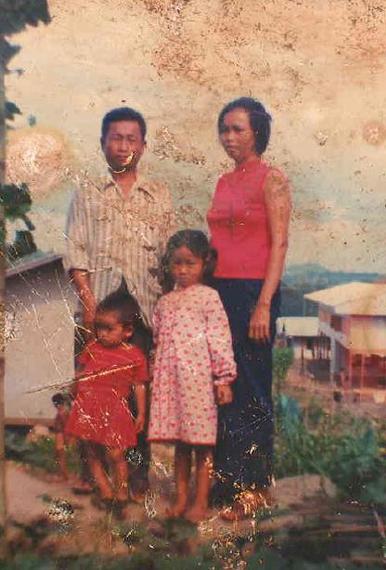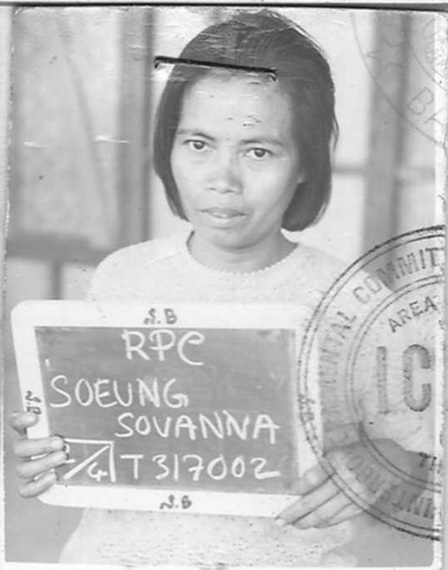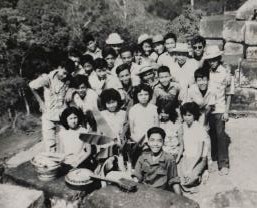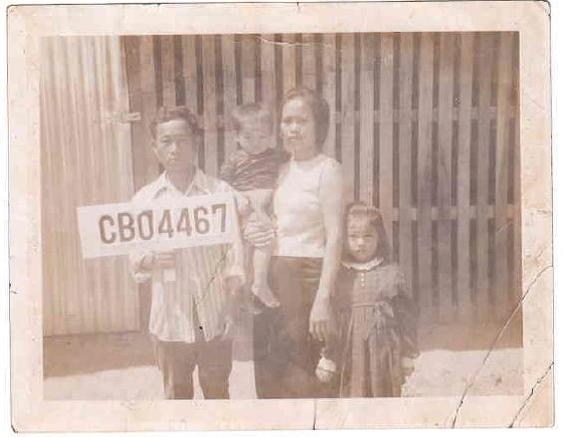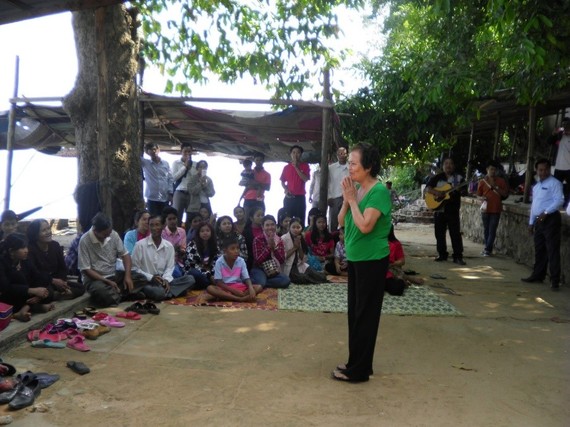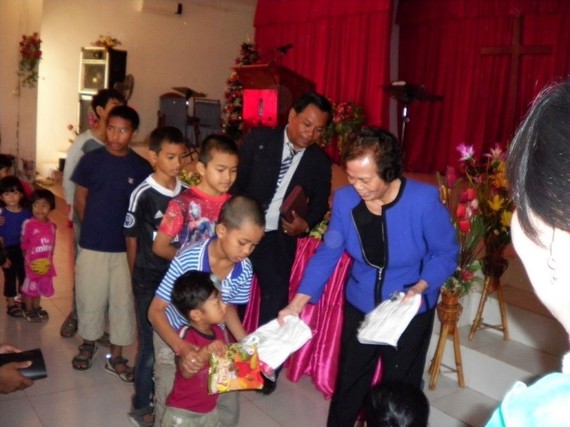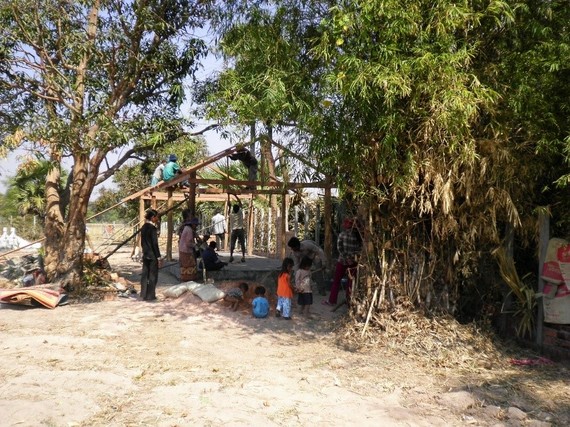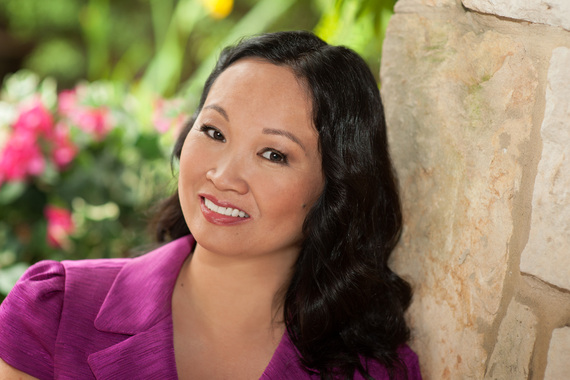While everyone was starving during the communist regime, my mother faced tigers in the wild jungle to find food for her family. When taken to be executed by the Khmer Rouge, she defied them, multiple times, and lived to tell the stories to her children. My mom has an incredible courage and stubborn will. I don't think my mother was fearless. Who wouldn't have fear living in the middle of a Genocide? However, she refused to let that fear win. She fought to live, and to save the lives of her family. My mom really does have "The Heart of a Tiger"... "The Heart of a Tiger" is a story about finding hope when there is no hope. It is a story of a woman who refuses to give up no matter how bleak her circumstances. It is the story of a woman whose love for her family gives her the courage to overcome brutal atrocities. And it is the story of how God's grace can shine through the incredible human capacity for kindness even in the midst of extraordinary evil. -Dr. SreyRam Kuy
Dr. SreyReath Kuy and Dr. SreyRam Kuy were recently interviewed by Aimee Herd, Editor of Breaking Christian News (BCN). This interview was originally published on June 26, 2015 and can be read here.
BCN Editor's note: I asked SreyRam and her sister SreyReath a few questions regarding their amazing journey. I hope you find their answers as enlightening and inspirational as did I.
Last month, Breaking Christian News published Part 1 of an article by Dr. SreyRam Kuy, detailing her family's journey as refugees from Cambodia--out of the Killing Fields of Khmer Rouge. SreyRam's mother's courage and strength were what they clung to after escaping the genocide headed by Pol Pot, trekking through a jungle littered with land mines, and surviving the desperation of refugee camps. SreyRam's mother was even miraculously healed after surviving a RPG explosion in one of those camps, before her family was finally sponsored to come to America by a church group. Read Part 1 of SreyRam's riveting account of survival here.
BCN: You mention a Christian group that sponsored you and your family to come to America. Did you ever find out what group that was, and what prompted that sponsorship?
SreyRam and SreyReath Kuy: My family was sponsored to the United States by a Seventh Day Adventist missionary group. Judy Aiken, a Seventh Day Adventist missionary volunteering in the Khao-i-Dang refugee camp which we were living in, helped us secure visas to come to the United States. We lost contact, and then several years later, we were reunited when Judy came to visit us in Corvallis, Oregon. We are so grateful to people like Judy, who sacrificed so much to travel across the globe, leaving her comfortable home and family, to help destitute refugees living in squalid refugee camps. We're grateful for that surgeon who operated on us and saved our lives. These people truly exemplify what it means to be the hands and feet of Christ. At the same time that my family experienced the evil atrocities during the Cambodian Killing Fields, we also experienced the extraordinary human capacity for God's amazing grace to shine through people.
These acts of kindness were what helped sustain us during these brutal years of the Cambodian Genocide and our time as displaced refugees. We don't know what prompted people to help us. There were millions of other people who died during the Killing Fields, and thousands of other refugees that waited for years in refugee camps, only to be turned away and forced to return to the devastation that they had run away from. I don't believe there is anything special about us. I'm just humbled and amazed at the miracles we experienced, unearned and undeservedly. All I know is that these acts of human kindness were how we saw the evidence of God in our lives.
I'm just humbled and amazed at the miracles we experienced... All I know is that these acts of human kindness were how we saw the evidence of God in our lives.
BCN: You describe a time when your mother was recovering from her operation to repair injuries after the RPG hit. She was lying in the Red Cross refugee medical tent, and a Christian group came in to pray over her and lay hands on her. At the time she didn't know what they were doing or what they were saying. Did you or she ever find out what group that was, and did she ever make contact with them again once she was in America?
SreyRam and SreyReath Kuy: While my mom was lying in the Red Cross tent, recovering from the trauma laparotomy following the explosion, a group came to pray and sing over my mom as she was recovering. At first she was startled and a little afraid of these strange people. They came back the next day, to pray for another woman who was also ill. After that, my mom never saw them again. She didn't know at the time who they were or what they were about. But she felt a surge of strength in her body that she had never felt before. It had been nearly two months since the explosion, and she had been too weak to walk up to that day. After the group prayed over her, she had the strength for the first time to get up and try to walk with help. She later learned that it was a Christian missionary group, but she never found out the name of that group.
BCN: Can you describe how exactly your mother, sister and you came to know Christ, and what difference that has made in your lives?
SreyRam Kuy: Coming to know Christ has been a journey, not an overnight event. Some people planted the first kernels of faith, other people watered the seeds, and later, completely different people were able to see the fruits of those early seeds of faith. God worked in increments in our life, and over generations.
As a young girl living in 1950's rural Cambodia, my mom was a stubborn child. She dreamed of obtaining an education and becoming a teacher. However, her spirited and rebellious nature was a contradiction to cultural norms and her old-fashioned father's ways of thinking. Her father believed that women should not be educated, as this made them "uppity" and insubordinate to their husbands. However, my mother stubbornly kept going to school despite daunting obstacles. Going to school wearing raggedly clothes, and lacking the money to pay for books and fees, she still excelled in school and became a teacher.
However, just as she began to enjoy the fulfillment of her dream, the entire country of Cambodia hit a political crisis. This started in the early seventies during the Cambodian Civil War and took a ruthless turn for the worst after the bloody war was lost to the communists and the Khmer Rouge took over the country. Pol Pot had a savage quest; he ordered the execution of all educated citizens, beginning the systemic murder of teachers, doctors, musicians, artists, government officials. Anyone identified as educated was executed, tortured or enslaved. Being educated was now a crime. The elite become the third class citizens of society and subsequently; the first to be killed. Under the leadership of Pol Pot, the Khmer Rouge were responsible for the slaughter of two million human lives during the Cambodian Genocide.

(This memorial serves as a reminder that children, as well as adults, were targets of the Khmer Rouge. This is one of the Killing Trees against which executioners brutally murdered children during the Cambodian Genocide.)
After working so hard to achieve an education, my mother now had to hide her identity as a teacher. She fought fiercely to save her life, and the lives of her children, during the four brutal years of the Killing Fields. When the Khmer Rouge took over Cambodia, a lot of people gave up in despair. Among those who weren't executed, some even committed suicide to escape the horrors of the regime. My mother, however, stubbornly refused to ever give up. She faced the Khmer Rouge killers with the same steely resolve that helped her succeed in school. While everyone was starving during the communist regime, my mother faced tigers in the wild jungle to find food for her family. When taken to be executed by the Khmer Rouge, she defied them, multiple times, and lived to tell the stories to her children. My mom has an incredible courage and stubborn will. I don't think my mother was fearless. Who wouldn't have fear living in the middle of a Genocide? However, she refused to let that fear win. She fought to live, and to save the lives of her family. My mom really does have "The Heart of a Tiger".
After surviving the four years of the Khmer Rouge Regime, we escaped out of Cambodia. We spent 1 and a half years living in four different Cambodian refugee camps before we got visas to come to the US, through the incredible help of the Seventh Day Adventists missionaries.
Arriving in the US, my mom held multiple jobs, working as housekeeper at Good Samaritan hospital, then on her evenings and days off cleaned houses for local doctors and professors. We worked in the fields with the migrant farm workers on the weekends and during the summers picking blueberries, strawberries, cherry tomatoes, green beans, and raspberries. But, on the rare Sundays that she wasn't working, mom would try to take us to church. When we first arrived in the US, we didn't speak any English. As a result, my mom often didn't understand the seemingly strange rituals we witnessed during our occasional visits to churches. She didn't really understand a lot about the Christian faith, and the customs of the church were even more confusing, but she felt compelled to keep trying to go when she could. In 1987, I was given my first Bible by Pastor Paulson at Grace Lutheran Church. It lay unread for years. We'd still intermittently try to go to church when we could, but we usually worked every Sunday. One hot summer day in sixth grade, while I was picking blueberries, a girl working on the row next to me, starting talking about the Bible, and how she read it every day. I don't really know why, but I went home and picked up that Bible I had been given years ago, and started reading it myself. Later, I began reading the stories from the Bible to my family in the evenings.
A few years later, my mom was working at the hospital, kneeling over a toilet, scrubbing it, when my mom felt God speak to her heart. Startled, she heard, "It's time to get baptized." She had no idea what it meant to be baptized, and she didn't know how to get baptized. However, shortly afterwards we met Pastor James Rehley, from Zion Lutheran church. I have no idea how he came into our lives. He started visiting our home in the evenings, teaching us about the Good News of Christ. Months later, my mom, my sister and I were baptized. Our life has never been the same since then.
I look back at my life, and I see that while 2 million people died during the Cambodian Killing Fields, we survived. Among those who survived the Genocide, thousands of Cambodians tried to escape, and died crossing the landmines that pockmarked the border. My family and I made it across the border safely. Then, after the RPG hit the refugee camp, we were severely wounded, and would have died if not for that volunteer surgeon. Because of him, today I'm a surgeon myself, taking care of our nation's veterans. I look back, and I am astonished and humbled. There is absolutely nothing I did to deserve to be alive, when so many other people were killed. I don't know why I survived, but I do think that I was picked out of that blueberry field for a purpose.
My family lived through a Genocide where millions of people died, either through execution, brutal torture, starvation, disease, or despair and suicide. However, God saved us time after time; from execution by the Khmer Rouge soldiers, from starvation during the inhumane conditions of the Killing Fields, and from the four to six million land mines that riddled the borders of Cambodia during our escape.
If I can inspire someone to have hope through this story, then my time was well spent. Jesus tells a parable about a wealthy man who gives each of his servants' talents. To one, he gave one talent, to the other two talents, to the last he gave five talents. The person who got five talents, put it to work, and multiplied it into five more. The one who got two talents, put that to work and earned two more. But the person who received one talent, was scared and buried it in the ground.
I don't want to live in fear. I want to have the courage to boldly go out and use every gift that I've been blessed with. That means making the most of every day I'm blessed to live in this incredible land of freedom. America is a blessed country. As an American, I have the freedom to dream, to get an education and to succeed. However, being successful is not determined by how much wealth you amass, but in how many people you help along the way.
America is a blessed country. As an American, I have the freedom to dream, to get an education and to succeed. However, being successful is not determined by how much wealth you amass, but in how many people you help along the way.
I wrote the book, "The Heart of a Tiger," to encourage others. This book is a testimony to God's incredible love and amazing grace. He has brought my family through so much. We have seen miracles after miracles in our lives. My message in "The Heart of a Tiger" is that despite what obstacles you face, God is greater than any obstacle. Despite how bleak your circumstances, God's grace is sufficient to enable you to emerge victorious.
"The Heart of a Tiger", is a story about finding hope when there is no hope. It is a story of a woman who refuses to give up no matter how bleak her circumstances are. It is the story of a woman whose love for her family gives her the courage to overcome brutal atrocities. And it is the story of how God's grace can shine through the incredible human capacity for kindness even in the midst of extraordinary evil.
My hope in sharing this story is to honor the legacy of the millions of lives lost during the Cambodian Genocide. Their lives need to matter. By remembering this legacy hopefully we can learn from humanity's tragic history to prevent it from repeating itself. "The Heart of a Tiger" is a searing story of courage, faith, and forgiveness through one of the worst atrocities in human history. This is a story that you will never forget.
BCN: Was it difficult for your mother to go back to visit Cambodia and the places where she experienced so much pain, and how did she deal with that?
SreyRam and SreyReath Kuy: My mom is incredible; I am amazed by what a heart she has to serve. She doesn't dwell on the atrocities she experienced. Instead, she always talks about the kindness she experienced. The first several times she went back to Cambodia, she went in search of people who had helped her during the Killing Fields to try to repay her debt of gratitude. These were people who had risked their lives to help save her life during the Khmer Rouge Communist regime, or shared food with her during the endemic starvation of the Killing Fields. There were many people that she never found, because they had died already. However, it gives her great joy whenever she can find someone to pay back their kindness. During her last three trips to Cambodia, my mom returned to share her faith. Her last trip was this past January/February during which she visited five Cambodian churches where she testified about how God's incredible grace enabled her to forgive and heal after her experiences in the Killing Fields. She helped baptize 33 people, brought 900 Cambodian language Bibles that she distributed, and brought new school uniforms and clothes that she shared with the local villagers.
A couple weeks into her trip, she visited one church, where the building was dilapidated with a broken roof. Despite the unsafe conditions, people still gathered, desperate to find hope. My mom immediately called my sister and me to help out. My mom provided the funds to rebuild a new church, and the villagers provided the manpower, with everyone from children to the elderly all pitching in.
My mom was determined to share the blessings she's experienced. At age seventy, my mom rebuilt a crumbling church, leads worship services, and shares her testimony about forgiveness, faith, and God's incredible miracles in her life.
BCN: SreyRam, as you hear of events such as the genocide against minorities by ISIS and Boko Haram in the Middle East, what message would you have to this nation's leaders, and also to fellow Christians, in light of the fact that you have lived through and have experienced similar atrocities?
SreyRam Kuy: In surgery, we talk about "never events". These are things that should never happen, such as a retained sponge, a death in the operating room, or a wrong site surgery. But, "never events" do happen. And when they happen in medicine, rather than forgetting about it, we take pains to remember, discuss and analyze it in detail, learn from it, and create interventions to try to prevent it from happening to another patient. Genocide is a "never event". It should never, ever happen. And yet, we have seen it occur during the Holocaust, the Rwandan Genocide and during the Cambodian Killing Fields. It keeps recurring, like a metastatic malignancy. The healing of humanity is analogous to the art of medicine. It is imperative that we talk about these events and never forget them, so that we can learn from the mistakes of our human history and develop interventions to prevent future genocides. I absolutely believe genocide should, and can, become a "never event."
"The Heart of a Tiger" is a story about finding hope when there is no hope. It is a story of a woman who refuses to give up no matter how bleak her circumstances. It is the story of a woman whose love for her family gives her the courage to overcome brutal atrocities.
And it is the story of how God's grace can shine through the incredible human capacity for kindness even in the midst of extraordinary evil.
Dr. SreyRam Kuy is Director of the Center for Innovations in Quality, Outcomes and Patient Safety at Overton Brooks VA Medical Center and Assistant Professor of Surgery at LSU - Shreveport. She has written for the Los Angeles Times, USA Today, the Washington Post, The Independent, the Huffington Post, Salon and the Wall Street Journal. Follow Dr. Kuy on Twitter @SreyRam or connect on LinkedIn and Facebook.
Dr. SreyReath Kuy is a podiatrist, caring for patients with severe complications of diabetes and renal diseases.

